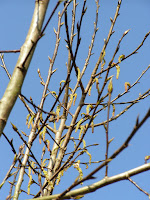
- Getting colour and structure all year round in the garden is a hard task. But plants and shrubs often overlooked during summer, when they are dwarfed by their showier cousins, are essential in winter and early spring.
When picking and placing your plants you need to look out for three things:
1. Structure
2. Colour
3. Interest
This becomes even more important over winter and early spring when you don’t have the sheer impact of colourful flowers to fall back on. Getting the right mix takes constant refinement. Not to mention discipline. It’s difficult to overlook all the striking summer plants and pick plants for winter. When you are picking any plants think about the area you plan to put them in. - What else is there? What will it look like over winter?
- Do you need plants to provide height or spread?
- How will the size, leaf shape and colour contrast with the other plants?

Here’s my favourite trees:
- Cherry trees (prunus) - comes in very different shapes and sizes and pink and white blossom looks wonderful in spring.
- Willow - my favourite is the contorted golden curls but willows come in all sizes. Choose a bush or smaller species depending on space. Kilmarnock willows are popular for small gardens.
- Acers/Japanese maples - with spectacular colour and feathery leaves these are a real show stopper in summer but choose one with red stems and you get a bit of winter interest too.
- Magnolia - great for white or pink spring flowers. Although magnolias are really slow growing some varieties do become large trees.
- Fruit trees - extend the season into the late autumn and go for an apple, pear or plum tree.

For added architectural impact leave grass heads (see photo) and the dried spires from last summers flowers to wave in the winter sky. Allium seedheads are also great fun and add interest (see photo). Our beech hedge also looks fantastic over winter with crisp copper leaves hanging on tight.
Next pick some bushy shrubs to give body and fill the middle layer of the garden out. Go for a mix of evergreen, those that have winter berries and those that have strong coloured stems.
My favourite winter shrubs:
- Daphne - evergreen with tiny winter flowers
- Dogwood (cornus) - striking bare red stems
- Photina - evergreen with bright red new growth in winter (see photo)
- Callicarpa - bare stem with clusters of pink berries in winter
- Forsythia - tall bare stems with bright yellow winter flowers (see photo)
- Camellia, & Azaleas- shiny leaves with big spring flower heads
- Rosemary, thyme and bay - all year round scent and fresh herbs for cooking

Lastly for the front of the beds choose some early flowering bulbs and smaller plants to bring some early cheer. Try:
- Pieris - great flame coloured new leaves
- Ajuga - low creeping plant that’s a vivid dark purple all year round
- Hellebores - pretty white cup flowers
- Cyclamen, Snowdrops, crocus and anemones - cheery early flowering bulbs


























